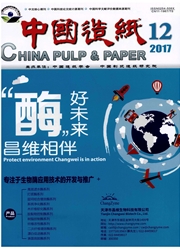

 中文摘要:
中文摘要:
选用季戊四醇(PETL)为多官能团支化剂,硝酸铈铵为引发剂,甲基丙烯酰氧乙基三甲基氯化铵(DMC)为阳离子单体,与丙烯酰胺(AM)在水溶液中发生自由基反应合成支化结构的阳离子聚丙烯酰胺(BCPAM)后,再加入正硅酸乙酯(TEOS)水解原位产生纳米SiO_2,在BCPAM分子中产生物理交联,制备超支化阳离子聚丙烯酰胺(SiO_2-BCPAM),研究了其作为纸张增强剂对纸张的增强作用,通过红外光谱(FT-IR)和扫面电镜(SEM)对产物的结构和特性进行表征。结果表明,所合成的产物为SiO_2-BCPAM杂化材料;引发剂、TEOS用量和反应时间影响SiO_2-BCPAM相对分子质量或分子链的形态进而影响其特性黏度;SiO_2-BCPAM对纸张增强效果明显,当其用量为0.5%(对绝干浆)时,纸张的抗张指数、耐破指数和撕裂指数比空白纸样分别提高了23.6%、12.4%和25.5%。
 英文摘要:
英文摘要:
Branched cationic polyacrylamide (BCPAM) was synthesized via free-radical solution polymerization of acrylamide (AM) and methacrylatoethyl trimathyl ammonim chloride (DMC) (DMC) by using pentaerythritol (PETL) as the core molecule and ceric ammonium nitrate (Ce4+ ) as the initiator. The Nano-SiO2 was produced in BCPAM by hydrolysis of tetraethyl orthosilicate (TEOS) in situ and the re- sulted SiO2 interacted with BCPAM through physical crosslinking. The structure of SiO2-BCPAM was characterized by Fourier transform infra- red spectroscopy (Fr-IR) and scanning electron microscopy (SEM). The study results indicated that the initiator concentration, TEOS dos- age and reaction time influenced the molecular weight or chain aggregation, and then the intrinsic viscosity. The SiO2-BCPAM exhibited sig- nificant paper strengthening performance. For instance, when the dosage of SiO2-BCPAM was 0.5% (based on oven dried pulp), the dry tensile index, burst index and tear index of the hand sheet were increased by 23.6%, 12.4% and 25.5% respectively.
 同期刊论文项目
同期刊论文项目
 同项目期刊论文
同项目期刊论文
 期刊信息
期刊信息
